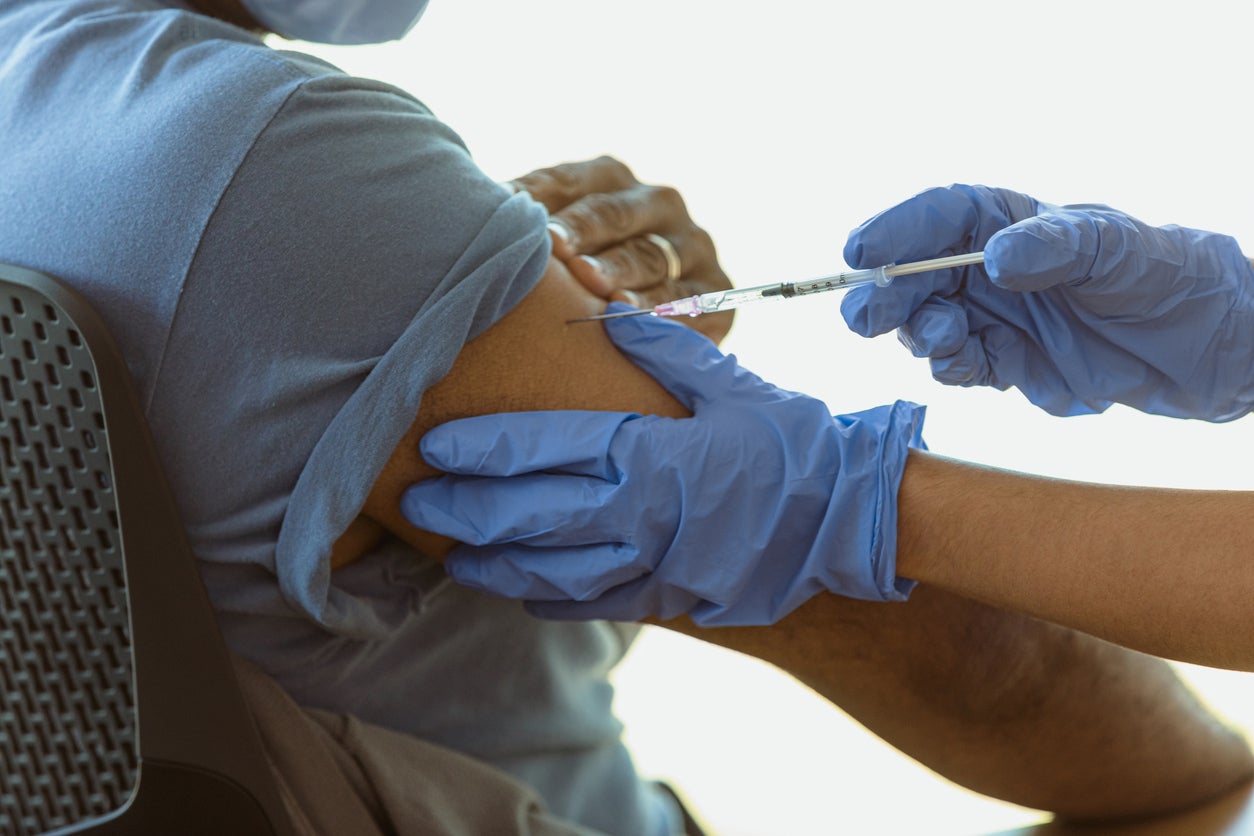Why we need to start talking about HRT for men
Brain fog, mood swings and low libido can all be signs of the ‘andropause’, which men can face from their forties. But instead of suffering in silence, ask for help, says Delia Von Neuschatz, who looks at the boom in testosterone replacement therapy and asks if more men should get their hormone levels tested

Whether it is Davina McCall talking about losing “something of herself”, Zoe Ball describing bouts of “meno-madness”, or Halle Berry declaring her menopausal status from the steps of the Capitol in Washington, the conversation around menopause has become loud and proud. And this in turn has resulted in important debates about legislation to protect the employment rights of women experiencing the debilitating effects of menopause, and treatments such as hormone replacement therapy (HRT) that can help to alleviate them.
However, absent from this discussion has been the issue of how a midlife hormone shift can affect men, too – and what can be done to relieve its symptoms, which can be equally distressing.
While the medical community is still divided as to whether the age-related drop in testosterone experienced by some men should be described as male menopause, it is sometimes referred to as the andropause, and it can manifest in men in their late forties and early fifties. Symptoms include depression, low libido, erectile dysfunction, insomnia, and a loss of muscle mass, and increasingly men are turning to TRT – testosterone replacement therapy – to help restore virility, strength and energy.
While maintaining a healthy weight and lifestyle is the best way to preserve testosterone levels, the demand for testosterone therapy has soared over the last two decades among men who believe they have “low T”.
There has been a proliferation of standalone “men’s health” clinics and online “low T” services, meaning that TRT is fast becoming a billion-dollar business, with the peak demand for prescriptions coming from men aged 50 to 60 years old, according to Dr Channa Jayasena, a consultant in reproductive endocrinology at Imperial College London.
Testosterone can be delivered via gel, patches, injections and pellets, which are small implants inserted under the skin that release hormones over the course of several months. However, studies show that up to 25 per cent of men who receive testosterone therapy are doing so without having their testosterone properly tested. While levels fall with age in most men, only a small number are truly testosterone deficient, which is leading to concerns about overprescribing.
Testosterone production in men peaks in their twenties and begins to decline at the rate of around 1 per cent per year in their thirties or forties. Approximately 10 per cent of men aged 40 to 60 have low serum testosterone, rising to 20 per cent among those aged 60 to 80 and 35 per cent in those aged 80-plus.
The numbers paint a different picture when it comes to testosterone deficiency, however. Dr Pierre-Marc Bouloux, a professor of endocrinology at University College London, explains that only 4-5 per cent of men above the age of 50 – around one in 20 – actually have symptomatic testosterone deficiency (or hypogonadism) and would benefit from hormone replacement therapy.

The distinction between “low T” or low serum (blood) testosterone levels and testosterone deficiency is an important one, because only those men who are testosterone deficient are considered to be good candidates for TRT. Merely having a low testosterone blood count is not enough.
A general slump in midlife can be put down to a number of age-related events, and leading endocrinologists believe that the explosion in testosterone prescribing in the UK over the past 20 years has, to some extent, been down to “exploiting the vulnerabilities and insecurities” of middle-aged and older men.
“There are lots of irresponsible and exploitative doctors out there preying on vulnerable patients,” says Dr Richard Quinton, an honorary reader in reproductive endocrinology at Imperial College London.
In fact, suggests Dr Jayasena, “the vast majority of men who are over the age of 40 should be reassured that they will never need testosterone”.
So how do you know if you need it or not?
Testosterone is a powerful hormone in both men and women. In men, it is mainly produced in the testes and is regulated by the brain’s hypothalamus and pituitary gland. It helps to maintain sex drive, muscle mass, bone density, sperm production, red blood cells, and facial and body hair.
While men think taking it prolongs their vigour and youth, too much testosterone can thicken the blood and worsen cholesterol levels slightly, says Dr Jayasena. According to American Urological Association guidelines, to be testosterone deficient is to have symptoms of low testosterone combined with low serum testosterone levels. A patient is considered testosterone deficient and therefore a candidate for testosterone therapy only when he meets both criteria.
These symptoms include loss of libido, decreased strength, anaemia, and osteoporosis or loss of bone density, as Dr Bradley Anawalt, a board-certified endocrinologist at the University of Washington School of Medicine, explains.
There are a lot of clinics that give growth hormones, TRT, and other things that are designed to make you feel like a ‘young man’ – that’s bogus
Even the presence of symptoms along with two separate blood tests showing a low serum testosterone level does not amount to a final diagnosis in itself, but is rather an entry point to making a full diagnosis. A “great” candidate for TRT, according to Dr Anawalt, is someone with an identifiable cause of testosterone deficiency – something that affects either the testicles’ ability to produce testosterone, or the centres in the brain that regulate the hormone.
A potentially “good” candidate for TRT is someone who has symptoms – say a loss of libido – and a low serum testosterone level, and is older, but doesn’t have an identifiable cause of testosterone deficiency.
This is where the issue gets controversial, because if these men have reversible conditions such as obesity, type 2 diabetes or sleep apnoea, then treatment of these illnesses through lifestyle intervention alone can often raise their testosterone level to a normal range. That is why, for this group, lifestyle prescriptions should always be the first course of action, advises Dr Bouloux.
“The first thing is to treat the underlying cause – high blood sugar or high BMI – through measures that include changes in diet, exercise, and, if appropriate, medications; we now have very potent medications that help with weight loss,” concurs Dr Anawalt.

Intriguingly, Dr Quinton cites a Chinese study that found that the older men who took part had higher levels of testosterone than their middle-aged counterparts. Some even showed the same hormone levels as they had in their youth. Why?
The older men had followed a traditional diet, while “middle-aged Chinese men had adopted a more Western diet and got obese”, says Dr Quinton. The takeaway, he explains, is that, in the overwhelming majority of cases, the decline in testosterone that comes with age doesn’t actually correlate with ageing. It correlates with the accumulation of comorbidities, including obesity, that occurs with the passage of time.
“Provided you are among the 90 per cent plus of men whose testes have the capacity to work just fine, if you don’t get obese and don’t get ill for other reasons, you will maintain the same testosterone level as younger men,” says Dr Quinton.
Still, comorbidities are not always reversible. Dr Jayasena mentions an overweight patient with a back injury that prevented him from exercising despite determined efforts. Low testosterone levels were interfering with his personal life – not being able to have an erection was affecting his ability to sustain relationships – so testosterone replacement therapy was initiated. “TRT has a good use, particularly when you can’t reverse the cause,” says Dr Jayasena.
Who is not a good candidate for TRT?
Men with testosterone levels in the normal range, but who claim they’re “low for their age”, will not benefit from TRT. “We commonly see this category of men all over the world,” says Dr Anawalt.
Older men who present with a low-ish blood testosterone level are not likely to benefit, he adds, because “we know from the major clinical trials that the biggest benefit of testosterone therapy is with men who have unequivocally low blood testosterone levels – and the lower they are, the more they benefit”.

Another group that won’t profit from TRT is men who have vague complaints – commonly seen in advertisements by drug companies. These include an inability to focus, decreased energy, and brain fog.
While men with a true testosterone deficiency who have these complaints may get better with TRT, “it’s unlikely that men who have those vague complaints and don’t have very low blood testosterone levels, or an identifiable cause of testosterone deficiency, will see an improvement”, says Dr Anawalt.
Men should only take the drug if there is a clear indication of medical need, and should weigh up the risks in discussion with their doctor. A small number of men can experience side effects such as acne, sleep disruption, and swelling in their ankles. Some older studies raised concerns that long-term treatment with TRT could increase the risk of cardiovascular disease or prostate cancer, but more recent clinical trials have provided reassurance on this front, concluding that, for men who have a diagnosed testosterone deficiency, there is no increased risk of heart attack or stroke, and no greater chance of developing prostate cancer.
Ultimately, whatever the online “low T” clinics say, it is imperative that men seeking this treatment should consult with a qualified endocrinologist and not a general practitioner, according to Dr Quentin. “It’s about your biological age,” says Dr Jayasena. “It’s about being fit and staying healthy.”
And finally, it’s worth remembering that testosterone is not the fountain of youth.
“It doesn’t turn old men into young men,” says Dr Anawalt. “There are a lot of clinics that call themselves hormone optimisation clinics, rejuvenation clinics – they give growth hormones, TRT, and other things that are designed to bring your testosterone and growth hormones up to that of a young man and make you feel like a young man – that’s bogus. Those men are actually taking it as a drug, not as replacement therapy.”
And that is probably about as effective as getting a midlife motorbike.






Join our commenting forum
Join thought-provoking conversations, follow other Independent readers and see their replies
Comments